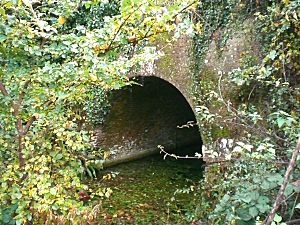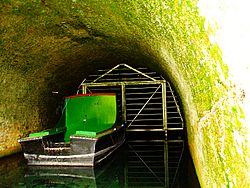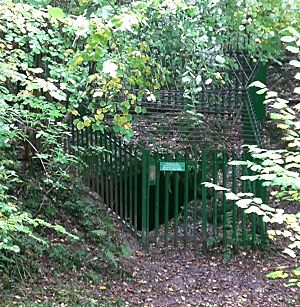Greywell Tunnel facts for kids
| Site of Special Scientific Interest | |

The eastern portal of the tunnel
|
|
| Area of Search | Hampshire |
|---|---|
| Interest | Biological |
| Area | 0.4 hectares (0.99 acres) |
| Notification | 1985 |
| Location map | Magic Map |
 |
|
| Inside the Greywell Tunnel | |
| Overview | |
|---|---|
| Location | Greywell |
| Coordinates | 51°15′38″N 0°58′44″W / 51.2605°N 0.978849°W |
| OS grid reference | SU713517 |
| Status | Disused (collapsed) |
| Waterway | Basingstoke Canal |
| Operation | |
| Closed | 1932 |
| Technical | |
| Construction | brick |
| Length | 1,230 yards (1,120 m) |
| Towpath | no |
| Boat-passable | no |
Greywell Tunnel is a special place in Hampshire, England. It covers about 0.4 hectares (1 acre) and is a Site of Special Scientific Interest (SSSI). This means it's protected because of its important wildlife, especially its huge bat population. The tunnel was once a key part of the Basingstoke Canal, a waterway used for transporting goods.
Contents
Building the Basingstoke Canal
Planning the Waterway
The idea for the Basingstoke Canal began in 1778. An official law was passed to allow its construction. The plan was to build a canal about 44 miles (71 km) long. It would connect Basingstoke to other waterways near Weybridge.
Initially, the canal route went around Greywell Hill. This large loop was designed to avoid going through land owned by Earl Tylney. However, the American Revolutionary War was happening, so construction didn't start right away.
A New Plan and Tunnel Construction
In 1787, a new plan was made for the canal. William Jessop, a famous engineer, surveyed the route. He suggested a big change: instead of a long loop, a tunnel would cut through Greywell Hill. This tunnel would shorten the canal by almost 7 miles (11 km).
Construction of the canal began in October 1788. The tunnel part was given to an engineer named Charles Jones. He had faced problems with another tunnel project before. Jones worked on Greywell Tunnel but was dismissed in 1789.
The main contractor, John Pinkerton, then took over. He had to make sure the bricks used for the tunnel were good quality. By June 1791, about 223 yards (204 m) of the tunnel were finished. The canal officially opened on September 4, 1794.
Challenges and Closure
Soon after opening, parts of the canal banks collapsed. This caused some sections to close until 1795. The quality of the tunnel's construction was also criticized.
The tunnel didn't have a towpath for horses. Boats had to be moved through by "legging." This meant people lay on their backs and pushed against the tunnel walls with their feet. It could take up to six hours to get a boat through!
The canal never became as busy as people hoped. Many companies tried to run it but failed. The last boat to pass through the tunnel was likely in 1914. This boat, named Basingstoke, carried sand. Its trip was meant to prove the canal was still usable.
The tunnel finally closed in 1932 when part of its roof collapsed. After this, the canal section west of the tunnel was sold. Even though it was blocked, canoeists could still get through until the late 1950s. Today, the tunnel is completely blocked.
A Home for Bats
Why Greywell Tunnel is Special
Greywell Tunnel is incredibly important for bats. It has more roosting bats than any other place in Britain! This is why it was made a Site of Special Scientific Interest (SSSI) in December 1985.
Scientists first studied the bat populations here in 1975. A count in the eastern part of the tunnel found 541 bats. Experts estimated there were around 2,000 bats in total at that time.
Bat Species and Their Habitat
Several types of bats live in the tunnel. These include:
- Natterer's bat (Myotis nattereri)
- Daubenton's bat (Myotis daubentoni)
- Whiskered bat (Myotis mystacinus)
- Brandt's bat (Myotis brandti)
- Brown long-eared bat (Plecotus auritus)
The tunnel is about 1,230 yards (1,125 m) long. The eastern part is cut through chalk. The western part is also open, but the middle section is filled with soft clay from the collapse.
Perfect Conditions for Bats
The blockage in the middle, along with several natural springs, creates a perfect environment for bats. The temperature inside the tunnel stays around 10°C (50°F) all year. This stable temperature is ideal for bats to hibernate in winter and roost in summer.
In colder weather, cold air flows into the tunnel's bottom. It gets warmed by the water inside. Then, warmer air flows out along the top. In summer, this air flow reverses. Warm air enters the top and cools as it flows back out over the water. This natural air conditioning keeps the tunnel comfortable for the bats.
By 2006, the bat population had grown to about 12,500 bats. This included the largest known group of Natterer's bats. Greywell Tunnel truly is a vital sanctuary for these amazing creatures.


